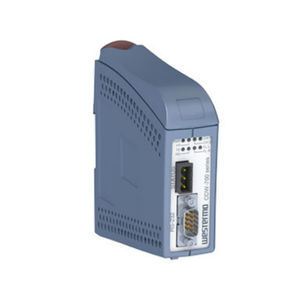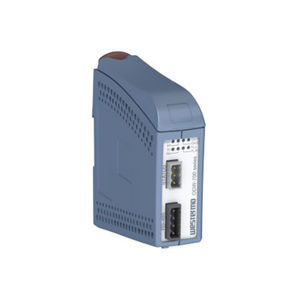

- Products
- Catalogs
- News & Trends
- Exhibitions
Multidrop modem TD-23 LVRS232VHFindustrial

Add to favorites
Compare this product
Characteristics
- Type
- multidrop
- Network
- RS232, VHF
- Application
- industrial
- Mounting
- DIN rail, DIP
- Other characteristics
- short-range
Description
The TD-23 is a simple industrial modem designed to allow cost effective and easy multidrop access (max 16 drops) to legacy serial industrial equipment. Any asynchronous word format can be used from either RS-232 or RS-485 protocols.
Designed with industrial locations in mind the modem can operate in extremes of temperature and electromagnetic field.The complete galvanic separation of all interfaces ensures earth loops and transients do not interfere with communication.
There is both a low voltage and high voltage power version available.
The modem is specifically designed for legacy V.23 systems at 300 to 1200 bit/s and can be used either for multidrop applications or as a driver for a “push to talk” VHF radio system (relay version). The unit’s transmitter can be controlled by hardware handshaking, but can also use the auto turning time functionality built in.
All options are configurable by DIP switch meaning that no laptop is needed for configuration.
Communication can be tuned for optimum performance by increase or reducing both receiver sensitivity and transmit power. A DCD and RXD filter also helps to improve performance with some older protocols.
Features
✓ Simple low cost multidrop network solution
• 1200 bit/s Multidrop Modem
• RS-232 and RS-422/485 interface
• Up to 25 km transmission
✓ Robust industrial solution for long service life
• Extended temperature –25°C to 70°C
• Extensive EMC approvals and tri-galvanic isolation
• Low voltage and high voltage version for DC and AC powering
Catalogs
No catalogs are available for this product.
See all of Westermo‘s catalogsRelated Searches
- Ethernet switch
- Industrial network switch
- Managed ethernet switch
- Gigabit ethernet switch
- DIN rail ethernet switch
- RJ45 ethernet switch
- Waterproof ethernet switch
- Communication gateway
- Unmanaged ethernet switch
- PoE ethernet switch
- Layer 2 ethernet switch
- Industrial communication router
- Ethernet communication router
- Ethernet gateway
- SFP+ ethernet switch
- DIN rail mounted converter
- Wireless gateway
- Rugged ethernet switch
- Ethernet converter
- VPN communication router
*Prices are pre-tax. They exclude delivery charges and customs duties and do not include additional charges for installation or activation options. Prices are indicative only and may vary by country, with changes to the cost of raw materials and exchange rates.






